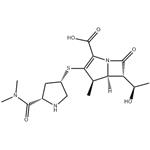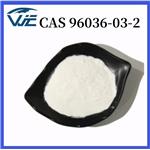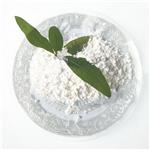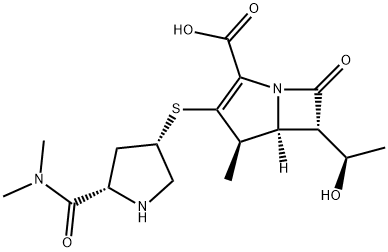Meropenem
- CAS No.
- 96036-03-2
- Chemical Name:
- Meropenem
- Synonyms
- MEROPENAM;MeropeneM Crude;Meropenem hydrate;(4r,5s,6s)-3-[[(3s,5s)-5-(dimethylcarbamoyl)pyrrolidin-3-yl]thio]-6-[(1r)-1-hydroxyethyl]-4-methyl-7-oxo-1-azabicyclo[3.2.0]hept-2-ene-2-carboxylic acid;STERILE MEROPENEM;Merrem;4R,5S,6S)-3-[[(3S,5S)-5-[(Dimeth-ylamino)carbonyl]-3-pyrrolidinyl]thio]-6-[(1R)-1-hydroxyethyl]-4-methyl-7-oxo-1-azabicyclo[3.2.0]hept-2-ene-2-carboxylic acid;SM 7338;Meronem;Meropen
- CBNumber:
- CB7459533
- Molecular Formula:
- C17H25N3O5S
- Molecular Weight:
- 383.46
- MDL Number:
- MFCD00864966
- MOL File:
- 96036-03-2.mol
- MSDS File:
- SDS
| Boiling point | 627.4±55.0 °C(Predicted) |
|---|---|
| Density | 1.42±0.1 g/cm3(Predicted) |
| storage temp. | Sealed in dry,Store in freezer, under -20°C |
| solubility | insoluble in EtOH; ≥19.15 mg/mL in DMSO; ≥9.88 mg/mL in H2O with ultrasonic |
| form | solid |
| pka | 4.27±0.60(Predicted) |
| InChI | InChI=1S/C17H25N3O5S/c1-7-12-11(8(2)21)16(23)20(12)13(17(24)25)14(7)26-9-5-10(18-6-9)15(22)19(3)4/h7-12,18,21H,5-6H2,1-4H3,(H,24,25)/t7-,8-,9+,10+,11-,12-/m1/s1 |
| InChIKey | DMJNNHOOLUXYBV-PQTSNVLCSA-N |
| SMILES | N12[C@@]([H])([C@@H]([C@H](O)C)C1=O)[C@@H](C)C(S[C@H]1C[C@@H](C(N(C)C)=O)NC1)=C2C(O)=O |
| CAS DataBase Reference | 96036-03-2(CAS DataBase Reference) |
| FDA UNII | YOP6PX0BAO |
| NCI Drug Dictionary | meropenem |
| ATC code | J01DH02 |
| EPA Substance Registry System | Meropenem (96036-03-2) |
SAFETY
Risk and Safety Statements
| Symbol(GHS) |  GHS07 |
|---|---|
| Signal word | Warning |
| Hazard statements | H335-H315-H319 |
| Precautionary statements | P264-P280-P305+P351+P338-P337+P313P-P264-P280-P302+P352-P321-P332+P313-P362 |
| Hazard Codes | Xi |
| Risk Statements | 36/37/38 |
| Safety Statements | 26-37/39 |
| HS Code | 29419000 |
Meropenem price More Price(22)
| Manufacturer | Product number | Product description | CAS number | Packaging | Price | Updated | Buy |
|---|---|---|---|---|---|---|---|
| Sigma-Aldrich | PHR1772 | Meropenem Pharmaceutical Secondary Standard; Certified Reference Material | 96036-03-2 | 500mg | $199 | 2021-12-16 | Buy |
| Cayman Chemical | 16068 | Meropenem ≥98% | 96036-03-2 | 10mg | $35 | 2021-12-16 | Buy |
| Cayman Chemical | 16068 | Meropenem ≥98% | 96036-03-2 | 25mg | $79 | 2021-12-16 | Buy |
| Cayman Chemical | 16068 | Meropenem ≥98% | 96036-03-2 | 50mg | $140 | 2021-12-16 | Buy |
| Cayman Chemical | 16068 | Meropenem ≥98% | 96036-03-2 | 100mg | $245 | 2021-12-16 | Buy |
Meropenem Chemical Properties,Uses,Production
Brand Name(s) in US
Merrem
Semi-synthetic carbapenem antibiotics
Meropenem is another kind of parenteral administrated semi-synthetic carbapenem antibiotics after imipenem-cilastatin has entered into market in the United State. It can inhibit the bacterial cell wall synthesis through binding with the penicillin-binding proteins involved in cell wall synthesis (PBPs) through its covalent bond, thus playing its antibacterial effect. Both Gram-positive bacteria and Gram-negative bacteria are sensitive to it. It has a particular strong antibacterial activity against gram negative bacteria. For example, the minimum inhibitory concentration (MIC) of it on about 90% of Enterobacter was about 0.08-0.15mg/L with more than 90% of the Pseudomonas aeruginosa strains (MIC <4mg/L) being highly sensitive to it as well as all Haemophilus including their ampicillin-resistant strains being highly sensitive to it (MIC of 0.06-1mg/L). Neisseria gonorrhoeae is also highly sensitive to meropenem whose activity is 15 fold as high as imipenem. Staphylococcus epidermidis, Staphylococcus saprophyticus and other coagulase-negative staphylococci is also sensitive to meropenem. The majority strains of Enterococcus faecalis are highly or moderately sensitive to meropenem. A concentration of MIC (0.06-4mg/L) of meropenem can almost suppress all of Bacteroides fragilis. Anaerobe such as Peptostreptococcus, Propionibacterium, and Actinomyces are also sensitive to meropenem.
Indications
Clinically, meropenem is suitable for treating the following infections caused by susceptible strains:
1. Respiratory infections such as chronic bronchitis, nosocomial pneumonia, lung abscess and empyema.
2. Intra-abdominal infections such as cholecystitis, cholangitis, liver abscess and peritonitis.
3. Urinary and reproductive system infections, such as pyelonephritis and complicated cystitis, endometritis, adnexitis, intrauterine infections, pelvic inflammatory disease and uterine connective tissue.
4. Bones, joints and skin and soft tissue infections such as cellulitis, anal abscess, osteomyelitis, arthritis, trauma, wound infection, burn wound infections, surgical wound infections, maxilla and mandible surrounding cellulitis.
5. Eye and ENT infections.
6. Empirical treatment; for patients of adult neutropenia with fever, the drug can be used alone or be used in combination with antiviral or antifungal drugs.
7. It can be used either alone or in combination with other anti-microbial agents for the treatment of complex infections.
8. Other serious infections, such as meningitis, septicemia.
Antibacterial scope
Gram-positive aerobes: Staphylococcus aureus (including β-lactamase producing strains), Staphylococcus epidermidis (including β-lactamase producing strains), Streptococcus pneumoniae, Streptococcus pyogenes, Streptococcus agalactiae, Streptococcus viridans, Enterococcus faecalis, Enterococcus feces, Nocardia, and Listeria monocyogenes.
Gram-negative aerobic bacteria: Klebsiella, Klebsiella ozaenae, Klebsiella pneumoniae, Legionella spp., Enterobacter aerogenes, Enterobacter cloacae, Escherichia coli, Pseudomonas, Pseudomonas aeruginosa, Morganella morganii, Salmonella, Salmonella typhi (including β-lactamase producing strains), Serratia, Shigella, Yersinia, deformation spp, Pasteurella spp., Neisseria gonorrhoeae, Citrobacter spp., Haemophilus, Haemophilus influenzae, Alcaligenes, Acinetobacter spp., and Campylobacter spp.
Gram-positive anaerobic bacteria: Actinomyces, Clostridium, Peptococcus, Peptostreptococcus and Propionibacterium.
Gram-negative anaerobic bacteria: Bacteroides, Bacteroides fragilis, Fusobacterium gangrene and veillonella.
Comparison among three kinds of carbapenems antibiotics
Meropenem, imipenem and panipenem, all these three kinds of carbapenems class antibiotics have good antibacterial activity against all kinds of G + and G-bacteria, aerobe and anaerobe. Clinically it is mostly used for treating the severe infection, mixed infection, nosocomial infection and immuno-deficient infection caused by enzyme-producing strain, and multi-drug resistant strains as well as G-strain.
The differences between the three antibiotics are as follows:
1, each of them has their own focus regarding its antibacterial effect. They have a similar antibacterial spectrum against the anaerobes. For aerobic non-fermentation gram negative bacteria, meropenem has the strongest antibacterial activity, followed by imipenem, panipenem. For G+ bacteria, panipenem has the strongest antibacterial activity.
2, for the adverse reactions of the central nervous system, the imipenem can cause the highest incidence with the incidence of the meropenem and panipenem being low.
3, Imipenem is unstable under the reaction of human renal dehydropeptidase, thus should be used in combination with the enzyme inhibitor cilastatin. Meropenem and panipenem is stable to the human renal dehydropeptidase. Panipenem have some extent of kidney toxicity with often being used together with betamethasone in order to reduce the nephrotoxicity.
4, imipenem and panipenem is only be available for intravenous injection. Intramuscular injection can also be applied for administration of meropenem.
The above information is edited by the Chemicalbook of Dai Xiongfeng.
Dosage
Meropenem injection Specification: 0.5g; 0.25g.
Solution preparation:
After dilution with a suitable solution, within 15 to 30 min, apply intravenous infusion or intravenous injection via dilution with sterile water in 3-5 minutes.
Adult
Intravenous administration: General dose: administer of 500 mg-1000 mg every eight hours. Dose upon severe infection: administer 500-2000 mg of drug every 8 hour.
Medication for special Populations:
1. Dose of renal insufficiency: for patients of creatinine clearance rate being 26mL/min-50mL/min, administer 1000 mg of drug at every 12 hours; for patients of creatinine clearance rate being 10mL/min-25mL/min, administer 500 mg of drug at every 12 hour; for patients with creatinine clearance being less than 10 mL/min, administer 500 mg of drug at every 24 hour.
2. Dose of patients of liver dysfunction: patients of mild liver dysfunction don’t need dose adjustment.
3. Dose of elderly patients: the elderly should reduce the dose due to prolonged half-life.
4. The dose upon dialysis: dialysis patients are recommended to increase the dose during hemodialysis.
Child
Pediatric dose should be 10-20mg/kg with 3 times a day.
Side effects
Serious adverse reactions are rare. Adverse reactions observed in clinical trials include the following:
1, inflammation in the injection site inflammation, thrombophlebitis and pain in injection site.
2, Rash, itching, and hives.
3, abdominal pain, nausea, vomiting, diarrhea.
4, reversible eosinophilia, thrombocytopenia, and neutropenia. Positive results in direct or indirect Coombs test occurred in some patients.
5, the concentration of serum bilirubin, transaminases, alkaline phosphatase and lactate dehydrogenase can reversibly increases.
6, headache and paresthesia.
7, oral and vaginal candidiasis.
Drug Interactions
1. Combined therapy with probenecid can reduce the plasma clearance of meropenem while extending the half-life of meropenem.
2. Simultaneous application of typhoid vaccine may interfere with the immune response of live typhoid vaccine.
3. It has been reported that combination with antiepileptic drugs can reduce the plasma concentrations of anti-epileptic drugs.
4. Combination with zidovudine, ondansetron, vitamins, doxycycline, diazepam, calcium gluconate and acyclovir belong to combination compatibility.
Uses
It is a kind of anti-infection drugs and a kind of antibiotics.
Description
Meropenem is a new carbapenem antibiotic introduced to market for the i.v. treatment of a wide variety of hospital infections such as lower respiratory tract, urinary tract, intraabdominal, gynecological and polymicrobial infections. Meropenem has a broad spectrum of antibacterial activity against most clinically important Gram-positive and Gramnegative aerobic and anaerobic bacteria with especially high potency against multiresistant Enterobacteriaceae and Pseudornonas aeruginosa. Compared with imipenem, the only other available carbapenem antibiotic, meropenem has the advantage of being dehydropeptidase 1 (DHP-1) stable and therefore does not need to be administered in conjunction with the DHP-1 inhibitor cilastatin. Meropenem is also being evaluated for treatment of resistant pseudomonal infections in cystic fibrosis patients.
Chemical Properties
1KG;
Originator
Sumitomo (Japan)
Uses
antineoplastic, PDGF receptor blocker, immunomodulator
Uses
Meropenem, is an ultra-broad spectrum injectable antibiotic used to treat a wide variety of infections, including meningitis and pneumonia.
Definition
ChEBI: Meropenem is a carbapenemcarboxylic acid in which the azetidine and pyrroline rings carry 1-hydroxymethyl and in which the azetidine and pyrroline rings carry 1-hydroxymethyl and 5-(dimethylcarbamoyl)pyrrolidin-3-ylthio substituents respectively. It has a role as an antibacterial drug, an antibacterial agent and a drug allergen. It is a carbapenemcarboxylic acid, a pyrrolidinecarboxamide, an alpha,beta-unsaturated monocarboxylic acid and an organic sulfide.
Manufacturing Process
3.10 g of trans-1-(p-nitrobenzyloxycarbonyl)-4-hydroxy-L-proline and 1.10 g of triethylamine were dissolved in 40 ml of dried tetrahydrofuran, and a solution of 1.20 g of ethyl chloroformate in 10 ml of dried tetrahydrofuran was added dropwise thereto at -25-35°C. After stirring at the same temperature for 50 min, 10 ml of concentrated aqueous ammonia was added dropwise to the mixture at -25-40°C. The temperature was then gradually elevated to room temperature, and the reaction mixture was stirred for 1 hour, followed by concentration under reduced pressure. To the residue were added 20 ml of water and 50 ml of diethyl ether. After ice-cooling, the thus formed white crystals were separated by filtration, washed successively with cool water and cool diethyl ether, and dried under reduced pressure to yield trans-1-(pnitrobenzyloxycarbonyl)-4-hydroxy-L-prolineamide. Melting point: 163.3-164.0°C.
A solution of 1.89 g of methanesulfonyl chloride in 10 ml of dried
tetrahydrofuran was added dropwise to a suspension of 2.32 g of trans-1-(pnitrobenzyloxycarbonyl)-4-hydroxy-L-prolineamide and 1.67 g of triethylamine
in 40 ml of dried tetrahydrofuran at room temperature. After stirring for 1
hour, the reaction mixture was concentrated under reduced pressure, and to
the residue were added 30 ml of water and 30 ml of diethyl ether. After
cooling, the resulting white crystals were separated by filtration, washed
successively with cool water and cool diethyl ether and dried under reduced
pressure to obtain trans-1-(p-nitrobenzyloxycarbonyl)-4-methanesulfonyloxyL-prolineamide. Melting point: 149.5-151°C.
A solution of 642 mg of thioacetic acid in 14 ml of dried dimethylformamide
was added to a suspension of 374 mg of 50% sodium hydride in 13 ml of
dried dimethylformamide in a nitrogen stream, followed by stirring at room
temperature for 25 minutes. To the mixture were added 975 mg of sodium
iodide and then a solution of 2.52 g of trans-1-(p-nitrobenzyloxycarbonyl)-4-
methanesulfonyloxy-L-prolineamide in 12 ml of dried dimethylformamide, and
the resulting mixture was heated to 70°C for 6 hours while stirring. The
reaction mixture was poured into a cool aqueous solution of sodium chloride
and extracted with benzene. The extract was washed successively with a 10%
aqueous solution of sodium sulfate and a sodium chloride aqueous solution,
dried over sodium sulfate and distilled off to remove the solvent. The resulting
crude crystals were washed with a warm mixed solvent of tetrahydrofuran and
benzene to obtain (2S,4S)-1-(p-nitrobenzyloxycarbonyl)- 2-carbamoyl-4-
acetylthio-L-prolineamide. Melting point: 168.5-169.5°C.
950 mg of (2S,4S)-1-(p-nitrobenzyloxycarbonyl)-2-carbamoyl-4-
acetylthiopyrrolidine was dissolved in 95 ml of methanol, and 2.59 ml of a 1 N
aqueous solution of sodium hydroxide was added thereto at room temperature
in an argon stream, followed by stirring at that temperature for 15 min. The
reaction mixture was neutralized with 2.59 ml of a 1 N aqueous solution of
hydrochloric acid and distilled off under reduced pressure to remove the
methanol. The thus precipitated crystals were filtered and washed with water
to obtain (2S,4S)-1-(p-nitrobenzyloxycarbonyl)-2-carbamoyl-4-
mercaptopyrrolidine. Melting point: 158-162°C.
To 1.33 g (20 mM) of activated zinc was added 20 ml of dried
tetrahydrofuran, and 8.8 ml of a 15% n-hexane solution of diethylaluminium
chloride was added thereto in a nitrogen stream under ice-cooling. A solution
prepared by dissolving 1.49 g (5.2 mM) of (3R,4R)-4-acetoxy-3-[(R)-1-(tbutyldimethylsilyloxy)ethyl]-2-azetidinone and 3.73 g (15.3 mM) of benzyl-αbromopropionate in 13.3 ml of dried tetrahydrofuran was added dropwise to
the mixture over a period of 30 to 40 min, followed by stirring for 1 hours.
Under ice-cooling, 2.8 ml of pyridine, 13.2 ml of water, 26.5 ml of ethyl
acetate and 13.2 ml of a 1 N hydrochloric acid aqueous solution were
successively added thereto, and the resulting mixture was filtered using
Celite. The filtrate was washed with water, and the organic layer was dried
over sodium sulfate and distilled off to remove the solvent. The resulting oily
residue was subjected to silica gel column chromatography to obtain an
isomeric mixture of 4-(1-benzyloxycarbonyl)ethyl-3-[(R)-1-(tbutyldimethylsilyloxy)ethyl]-2-azetidinone.
The isomeric mixture was separated into each compound by Lober column
chromatography using silica gel and 1.5% isopropanol/n-hexane as an eluent
to obtain the compound (1a) and the compound (1b) as oily substances.
200 mg of 4-(1-benzyloxycarbonyl)ethyl-3-[(R)-1-(t-butyl-dimethylsilyloxy)
ethyl]-2-azetidinone (1a) was dissolved in 2 ml of dried dimethylformamide.
126 mg of triethylamine was added to the resulting solution, and then 151 mg
of t-butyldimethylsilyl chloride was added thereto, followed by stirring at room
temperature overnight. The reaction mixture was diluted with ethyl acetate,
washed with water, dried over sodium sulfate and purified by silica gel
chromatography to obtain 4-(1-benzyloxycarbonyl)ethyl-3-[(R)-1-(tbutyldimethylsilyloxy)ethyl]-1-(t-butyldimethylsilyl)-2-azetidinone (2a).
184 mg of (2a) was dissolved in 4 ml of methanol, and the resulting solution
was stirred together with 20 mg of 10% palladium-on-carbon at an
atmospheric pressure of hydrogen for 2 hours. The catalyst was removed by
filtration, and the filtrate was concentrated under reduced pressure to obtain
4-(1-carboxy)ethyl-3-[(R)-1-(t-butyldimethylsilyloxy)ethyl]-1-(tbutyldimethylsilyl)-2-azetidinone (3a).
(4R,5R,6S,8R)-p-Nitrobenzyl-4-methyl-6-(1-hydroxyethyl)-1-azabicyclo
[3.2.0]-hept-3,7-dione-2-carboxylate was obtained from 170 mg of 4-(1-
carboxy)ethyl-3-[(R)-1-(t-butyldimethylsilyloxy)ethyl]-1-(t-butyldimethylsilyl)-
2-azetidinone (3a) according to the method described in Japanese Patent
Application OPI No. 26887/83, pages 64-65.
(a) 53 mg of (4R,5R,6S,8R)-p-nitrobenzyl-4-methyl-6-(1-hydroxyethyl)-1-
azabicyclo[3,2,0 ]-hept-3,7-dione-2-carboxylate was dissolved in 5 ml of dry
acetonitrile, and 57 mg of diisopropylethylamine and then 43 mg of diphenyl
chlorophosphate were added thereto. After stirring for 2.5 hours, 57 mg of
[2S,4S]-1-p-nitrobenzyloxycarbonyl-2-dimethylaminocarbonyl-4-
mercaptopyrrolidine was added to the mixture, followed by stirring for 1 hour.
The reaction solution was diluted with ethyl acetate, washed with water, dried
over magnesium sulfate and the solvent was distilled off. The residue was
purified by silica gel thin layer chromatography to obtain 35 mg of
(4R,5S,6S,8R,2'S,4'S)-p-nitrobenzyl-3-[4-(1-p-nitrobenzyloxycarbonyl-2-
dimethylaminecarbonyl)pyrrolidinylthio]-4-methyl-6-(1-hydroxyethyl)-1-
azabicyclo[3,2,0]-hept-2-ene-7-one-2-carboxylate.
(b) 25 mg of (4R,5S,6S,8R,2'S,4'S)-p-nitrobenzyl-3-[4-(1-pnitrobenzyloxycarbonyl-2-dimethylaminecarbonyl)pyrrolidinylthio]-4-methyl-6-
(1-hydroxyethyl)-1-azabicyclo[3,2,0]hept-2-ene-7-one-2-carboxylate was
dissolved in a mixture of 1.9 ml of tetrahydrofuran and 0.3 ml of ethanol, and
the mixture was hydrogenated in a morpholinopropanesulfonic acid buffer
solution (pH = 7.0, 1.9 ml) under atmospheric pressure of hydrogen for 3
hours at room temperature in the presence of 30 mg of 10% palladiumcarbon, which had been activated in hydrogen atmosphere for 1 hour followed
by washing with water. After filtering off the catalyst, tetrahydrofuran and
ethanol were distilled off under reduced pressure, and the residual solution
was washed with ethyl acetate. The aqueous layer was again distilled under
reduced pressure to remove organic solvents, and the residual solution was
subjected to polymer chromatography (CHP-20P) to obtain
(4R,5S,6S,8R,2'S,4'S)-3-[4-(2-dimethylaminecarbonyl)pyrrolidinylthio]-4-
methyl-6-(1-hydroxyethyl)-1-azabicyclo[3,2,0]hept-2-ene-7-one-2-carboxylic acid from the fraction eluted with water.
brand name
Merrem I.V. (AstraZeneca).
Therapeutic Function
Antibiotic
Clinical Use
Meropenem is a synthetic carbapenem possessing a complex side chain at C-3. It also has a chiral methyl group at C-4. This methyl group conveys intrinsic resistance to hydrolysis by dehydropeptidase-1. As a consequence, it can be administered as a single agent for the treatment of severe bacterial infections.
in vitro
the meropenem mics for penicillin-resistant streptococcus pneumoniae were higher than for the penicillin-susceptible strains but the organisms remained susceptible. clinical susceptibility in vitro to meropenem was defined by mics of ≤4 mg/l, intermediate susceptibility by mics of 8 mg/l and mics of ≥16 mg/l define resistance; equivalent figures for zones of growth inhibition were ≥14 (susceptible), 12-13 (intermediate) and ≤11 (resistant) mm [1].meropenem was 2- to 4-fold more active than imipenem against gram-negative organisms and its spectrum of antimicrobial activity was wider than those of all other drugs tested.meropenem inhibited all anaerobic bacteria at less than or equal to 8 mg/l and 0.25 mg/l inhibited 50% of strains. meropenem mics were not significantly influenced by high inocula and the drug was generally bactericidal [2]. meropenem bound most strongly to penicillin-binding protein 2 of escherichia coli and pseudomonas aeruginosa, and to penicillin-binding proteins 1 of staphylococcus aureus [3].meropenem had one identified metabolite, a β-lactam ring-opened form which is devoid of microbiological activity [4].
in vivo
in rabbits, meropenem significantly increased the plamsa total clearance of valproate to about 1.5 times compared to the control (6.09 ml/min/kg vs. 4.28 ml/min/kg). meropenem significantly increased the urinary excretion of valproate- glucuronide in rabbits [5].
References
[1] edwards j r. meropenem: a microbiological overview [j]. journal of antimicrobial chemotherapy, 1995, 36 (suppl a): 1-17.
[2] jones r n, barry a l, tbornsberry c. in-vitro studies of meropenem [j]. journal of antimicrobial chemotherapy, 1989, 24 (suppl a): 9-29.
[3] yang y, bhachech n, bush k. biochemical comparison of imipenem, meropenem and biapenem: permeability, binding to penicillin-binding proteins, and stability to hydrolysis by β-lactamases [j]. journal of antimicrobial chemotherapy, 1995, 35 (1): 75-84.
[4] drusano g l, hutchison m. the pharmacokinetics of meropenem [j]. scandinavian journal of infectious diseases.supplementum, 1994, 96: 11-16.
Meropenem Preparation Products And Raw materials
| Supplier | Tel | Country | ProdList | Advantage | |
|---|---|---|---|---|---|
| Shenzhen Excellent Biomedical Technology Co.,Ltd. | +86-0755-26050679 +86-15915472436 | sale@ex-biotech.cn | China | 1031 | 58 |
| Hebei Mojin Biotechnology Co., Ltd | +8613288715578 | sales@hbmojin.com | China | 12456 | 58 |
| Henan Fengda Chemical Co., Ltd | +86-371-86557731 +86-13613820652 | info@fdachem.com | China | 7845 | 58 |
| Capot Chemical Co.,Ltd. | 571-85586718 +8613336195806 | sales@capotchem.com | China | 29797 | 60 |
| Henan Tianfu Chemical Co.,Ltd. | +86-0371-55170693 +86-19937530512 | info@tianfuchem.com | China | 21691 | 55 |
| ATK CHEMICAL COMPANY LIMITED | +undefined-21-51877795 | ivan@atkchemical.com | China | 32480 | 60 |
| Shanxi Naipu Import and Export Co.,Ltd | +86-13734021967 +8613734021967 | kaia@neputrading.com | China | 1011 | 58 |
| career henan chemical co | +86-0371-86658258 | sales@coreychem.com | China | 29914 | 58 |
| Hubei Jusheng Technology Co.,Ltd. | 18871490254 | linda@hubeijusheng.com | CHINA | 28180 | 58 |
| Hebei Guanlang Biotechnology Co., Ltd. | +86-19930503282 | alice@crovellbio.com | China | 8823 | 58 |
Related articles
- Meropenem: Antimicrobial Activity, Susceptibility, Administration and Dosage, Clinical Uses etc.
- Meropenem is a broad-spectrum parenteral carbapenem with antimicrobial activity against a wide range of Gram-negative and Gram....
- Apr 12,2022
View Lastest Price from Meropenem manufacturers
| Image | Update time | Product | Price | Min. Order | Purity | Supply Ability | Manufacturer | |
|---|---|---|---|---|---|---|---|---|
 |
2024-03-29 | Meropenem
96036-03-2
|
US $8.00-1.00 / kg | 1kg | 99% | g-kg-tons, free sample is available | Henan Fengda Chemical Co., Ltd | |
 |
2023-08-16 | Meropenem
96036-03-2
|
US $50.00 / KG | 1KG | >99% | 20tons | Weijer International Trade (Hebei) Co., Ltd | |
 |
2023-07-05 | Meropenem
96036-03-2
|
US $0.00 / KG | 1KG | 99% | 50000KG/month | Hebei Mojin Biotechnology Co., Ltd |
96036-03-2(Meropenem)Related Search:
1of4





